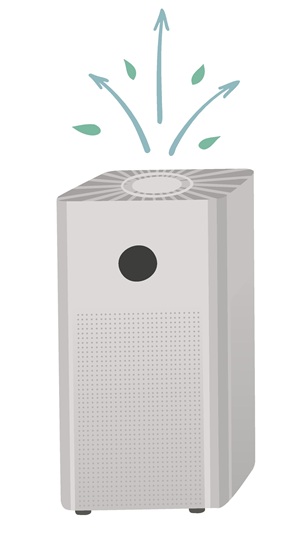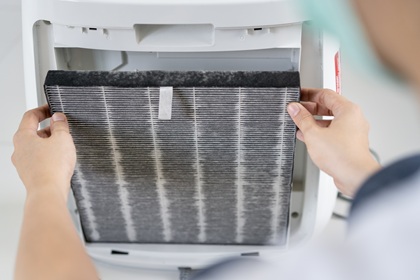
Portable air cleaners, also known as air purifiers, are devices that remove air contaminants from indoor air. Once you’ve chosen a portable air cleaner, it’s important to think about how to use it. Where a portable air cleaner is placed, how it is operated, and how it is maintained will change how well it will remove indoor air contaminants.
Put Your Portable Air Cleaner Where It’s Most Effective
Which Room
Choose a room that’s not too big based on the “smoke” or “tobacco smoke” Clean Air Delivery Rate (CADR). If the room is bigger than a portable air cleaner is designed for, the device will not work as well. See choosing a portable air cleaner. However, it’s most important to choose a room where you spend time to get the most benefit from your portable air cleaner.
Consider creating a cleaner air room. Watch a video and learn how to create a cleaner air room, EPA.
Where in the Room
Make sure devices are located away from exhaust vents so that cleaned air goes into the room. Find a dedicated space for the portable air cleaner where it is unlikely to be unplugged and will not have items placed on top of or around it.
Place the portable air cleaner away from walls and furniture that would block the air flow around it. Find a space away from drafts such as open windows, doors, or air supply vents that can affect air flow into and out of the device. Place the device up off the ground if possible.
Avoid spreading airborne infectious diseases. In places like classrooms, long term care facilities, and child care facilities, point devices so they do not blow air from one person to another.
Windows and Doors
While the device is running, keep windows and doors closed so that it will be most effective. This includes internal doors and those to the outside.
Run Your Portable Air Cleaner Before, During, and After Contaminants are Present

When to Run
Portable air cleaners can be used at any time to remove contaminants from indoor air. They are especially useful when there is a source of particles in the building such as an airborne disease outbreak or wildfire smoke. For commercial buildings and schools, start portable air cleaners one hour before students and staff arrive. Run while the building is occupied. Continue for at least a few days after an event.
Technologies Other Than Filtration
Avoid portable air cleaners with additional technologies like UV lights and ionizers because these technologies can produce harmful air pollutants. See choosing a portable air cleaner. If you already have a portable air cleaner with additional technologies, turn the technology function off if there is an option to do so. Do not use essential oil functions.
Fan Speed
Higher fans speeds reduce contaminant concentrations more effectively. Run your portable air cleaner at the highest comfortable fan speed. Except during periods of airborne disease, use the “auto” setting, if available, to automatically adjust the fan speed.
Adjust Your Portable Air Cleaner’s Settings to Encourage Use

Noise
Higher fan speeds are more effective in removing contaminants but can generate more noise. To reduce noise:
- Except during periods of airborne disease, use the “auto” setting if your device has a sensor and can automatically adjust the fan speed.
- For homes, if your air cleaner doesn’t have an “auto” setting, keep the fan at a comfortable speed. Turn the speed up while you are cooking, cleaning, or generating other indoor air pollution, or if the outdoor air quality is bad.
- Consider finding a device with a CADR for a larger size room, or using multiple devices, and running at a lower fan speed.
The U.S. EPA recommends keeping indoor noise levels below 45 decibels (dB). 40 dB is roughly the noise level of a humming refrigerator. 80 dB is about the noise level of a leaf blower. You can use the Sound Level Meter App, CDC or a similar app on a smart phone to measure noise levels.
For spaces such as schools, childcares, adult care facilities, or offices, check for noise requirements.
Tampering
Check to see whether your device’s display can be locked if you’re concerned about tampering. If the portable air cleaner is in a public or community space, remind people why it’s important to leave it on.
Display Brightness
Check to see whether your device’s display can be turned off if the device is too bright at night.
Keep Your Portable Air Cleaner Running Well

Filter Replacement
Replace the HEPA and carbon filters regularly. Follow the device indicator or manufacturer’s recommendations. Consider replacing the filter after poor air quality events (when the air quality is in the Unhealthy for Sensitive Groups or worse AQI range or following any wildfire smoke event). If the filter changes color or if the air flow coming out of the air cleaner drops, it may be time to change the filter. Pre-filters, which collect the largest particles and are included in some portable air cleaner models, may also need to be replaced.
Unplug the air cleaner before changing the filter. Consider taking it outside to avoid spreading collected dust inside. Ventilate, clean with a HEPA vacuum cleaner, and wipe surfaces with a damp cloth afterward if changed indoors. Make sure the new filter fits well inside the device with no air gaps.
If you have a do-it-yourself (DIY) box-fan filter, replace the filter after poor air quality events and when the filter looks dirty.
Keep extra filters on hand, especially during wildfire smoke season.
Cleaning
Portable air cleaners should be vacuumed and cleaned after heavy use or every few weeks. Do this with the device unplugged. Wipe the device with a damp cloth and fragrance free soap or mild detergent. Always follow manufacturer recommendations to avoid shock hazards. Filter disinfection is not needed or recommended.
If there is a washable or vacuumable pre-filter, wash or vacuum it following the manufacturer’s recommendations to keep the device running efficiently.
Other Ways to Improve Indoor Air
A portable air cleaner won’t remove all indoor air pollutants. It’s important to remove sources of contaminants and ventilate when outdoor air quality is good. See other ways to improve your indoor air quality.
More Information
Choosing a Portable Air Cleaner
Ventilation and Air Quality for Reducing Transmission of Airborne Illnesses (PDF)
Guide to Air Cleaners in the Home, EPA
Air Cleaners for Asthma Programs, Regional Asthma Management and Prevention
